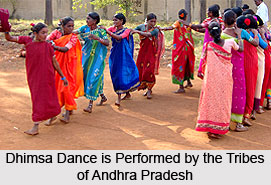 Dhimsa dance is among the Indian tribal dances. It is a dance form of the tribes in the eastern part of Andhra Pradesh, such as Araku Valley in Visakhapatnam district. The dance is also practised in the tribal regions of Orissaand Madhya Pradesh. The prominent tribes involved in this dance form include Bagata, Valmiki, Kotia and Khond. Furthermore, various critics trace the origin of Dhimsa dance to the Koraput area of Orissa. Dhimsa dance is performed during festivals, weddings and also at the time of the "hunting festival" in April when men and women dance for hours. During other festivals, the performers belonging to one village visit another village to dance and to take part in community feast. "Sankidi Kelbar" is the term for such dances. This dance is popular for promoting fraternity and friendship among the people of different villages.
Dhimsa dance is among the Indian tribal dances. It is a dance form of the tribes in the eastern part of Andhra Pradesh, such as Araku Valley in Visakhapatnam district. The dance is also practised in the tribal regions of Orissaand Madhya Pradesh. The prominent tribes involved in this dance form include Bagata, Valmiki, Kotia and Khond. Furthermore, various critics trace the origin of Dhimsa dance to the Koraput area of Orissa. Dhimsa dance is performed during festivals, weddings and also at the time of the "hunting festival" in April when men and women dance for hours. During other festivals, the performers belonging to one village visit another village to dance and to take part in community feast. "Sankidi Kelbar" is the term for such dances. This dance is popular for promoting fraternity and friendship among the people of different villages.
Features of Dhimsa Dance
The dance is simple and encompasses unique rhythm. Unique tribal musical instruments accompany this dance form including Kiridi, Mori, Dappu, Tudumu and Jodukommulu. Dhimsa dance presents an enthralling sight because of the earthy colours of the tribal wear. The beauty of this dance centres on the movements of the dancers without much emphasis on expression or literary texts. The movements of the dance form are quite expressive. The feet and the hand movements dominate the dance. An elemental rhythm and animated quick steps with manoeuvres are the distinctive features of the dance form. The attire is colourful; shades of red, yellow and green are worn. Dhimsa dance provides an impression to the onlookers of a collective performance that matters with each of them complementing the other and merging into a unifying whole. The dance is mainly performed by females and sometime male performers also join in. Duration of each dance remains approximately for 10 minutes.
Categories of Dhimsa Dance
Dhimsa dance has been categorized into eight kinds. Boda Dhimsa is performed to honour the village goddess and is a worship dance. Gunderi Dhimsa, also known as Usku Dhimsa, is another form in which the male dancer invites the female one to dance with him. Afterwards both dance in an exquisite manner. Goddi Beta Dhimsa is performed in a swing pattern by both male and female dancers. Picking up of leaves is symbolized by Potar-Tola Dhimsa. Bhag Dhimsa is the depiction of escaping from tiger`s attack. Natikari Dhimsa represents solo dance performance on the festival of Diwali by the Valmikis. Kunda Dhimsa is another rhythmic dance form. The dance of tribal magician is known as Baya Dhimsa which depicts him as possessed by the village goddess.
Dhimsa dance is also performed by the farming folk of Andhra Pradesh. The dance of the Porja caste is considered to be an exclusive women`s dance. The dance form is dedicated to the welfare of the domestic life. The men and women of the Porja caste perform the Dhimsa dance with great fervour. It is considered a must for newly-wed because on this day the women pray for a peaceful and happy married life. The dance is performed by women around in unison holding their hands together. Dhimsa dance form is the representation of communal harmony.



















